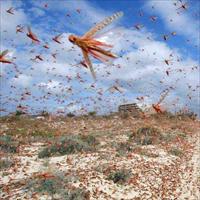EAST AFRICA: Locust infestation serious in Kenya and Ethiopia, says FAO

The locust infestation remains serious in northeast Kenya and southeast Ethiopia, according to the UN Food and Agriculture Organization (FAO).
"There have been new reports of infestations further west in both countries," FAO's Desert Locust Bulletin stated in its 11 December situation update report.
Swarms of locust, originating from Somalia, began to infest Kenya's northeastern district of Mandera and some areas in the Somali region of eastern Ethiopia at the end of November but have since moved to other parts of the two countries.
"In Kenya, at least one mature swarm crossed the Ethiopian border into Moyale district, west of Madera, where it was seen near Goda on November 30," the bulletin explained. "In Southeast Ethiopia, locust adults have been seen flying in the Borena zone of Oromia region, which is west of Ogaden and north of Kenya."
Lema Gebeyehu, head of the Crop Protection Division in the Ethiopian Ministry of Agriculture and Rural Development, confirmed to IRIN that locusts covered 375 hectares of land in Yabello and Teltale of Borena zone.
"Large numbers of adult locusts were reported in the districts of Moyale, Dire, Arero and Yabelo," the bulletin added.
According to experts, an average swarm consists of 40 million locusts and a single locust can eat two grammes at a day.
"The locusts will not affect the crop in the area due to the dry season," Lema said. "However, they will damage the pasture availability in the area."
The Desert Locust Control Organization for Eastern Africa (DLCO) has already begun a verification assessment in the two areas. "After finalising the verification we will begin aerial control operations," said Abdurhaman Abdulahi, a senior research officer at DLCO.
He believed the locusts originally came from Somalia but "due to the current situation in Somalia, it is not possible to conduct a control operation there”.
Abdurhaman said the adult locusts migrated from Somalia, laid their eggs in Kenya and hatched the hoppers in five places in Mandera.
He added that such a locust infestation "had not been seen for the last 40 years". DCLO categorises locust infestations as calm, upsurge and plague. This one had reached the "upsurge stage".
 Back and Next - Back and Next
Back and Next - Back and Next See Also - See Also
See Also - See Also